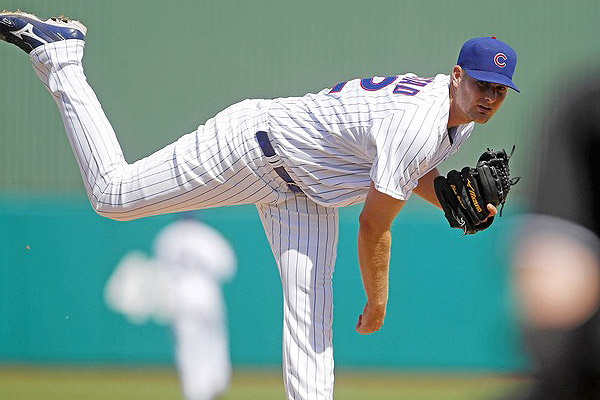
When the Cubs acquired Chris Volstad from the Marlins, there was some logic behind it. He's young, and there was evidence to indicate that he was unlucky last year:
Chris was prone to the long ball in 2011 (15.5% HR/FB) and it led to a miserable season with a near 5 ERA. His xFIP puts his talent level at 3.5. While not a great number, it is still decent and useable in most leagues. Again, ignore the losses and ERA and look to buy low with other pitchers around the 6 K/9, 3 BB/9 and 50% GB rate.
Translation: xFIP is supposed to separate pitching from fielding, suggesting that Volstad was not a terrible pitcher in 2011, but a mediocre pitcher with a bad defense behind him. This has been the story with Volstad for awhile now:
Last year, Volstad was a disappointment, posting a 4.89 ERA. However, his SIERA was easily a career best at 3.84, as his strikeout rate jumped, backed by a career best SwStk%, and walk rate dropped below 3.0. A perfect storm of an inflated BABIP and HR/FB ratio, which concurrently pushed his LOB% below 70%, ensured his season would look a lot worse than it should have. The move to Chicago isn’t likely to help him, all else equal, but he is due for some better luck.
So: Volstad shows some signs of turning around, and he's of the age to do that. Makes sense.
Last night Volstad got touched for eight hits and four runs in five innings against the worst team in baseball. He's now 0-9 in 12 starts with an ERA just under seven, and has the lowest left-on-base percentage for any pitcher with at least 60 innings pitched at 54.7 (only two pitchers over the last five years have pitched 60 innings and had a lower rate). And yet… Vostad still isn't as bad as his record would indicate. He's really a mystery.
* He has the second-lowest run support in baseball, 2.56 runs per nine innings. Even if Volstad were pitching well, with that run support he'd still be losing a lot of games, but he'd be a merely bad 2-7 with decent run support instead of a terrible 0-9.
* His rate stats really aren't that bad: he doesn't give up an unusual number of home runs or walks. He doesn't strike out that many people, but he's also a good ground-ball pitcher. His home run/fly ball ratio isn't unusual.
Except… he falls apart with men on base. With the bases empty, he walks four percent of batters. With men on base, he walks 10.4 percent of batters (in 2012; in 2011 and 2010 he had similar if less severe problems). With men in scoring position, he walks 16.9 percent of batters. And basically everything else gets worse as he goes from bases empty to men on base to men in scoring position. His home run rate goes up; opponents' batting average goes up; batting average on balls in play goes up.
It's not terribly unusual for a pitcher to get worse with men on base, because they have to go from the windup to the stretch. But Volstad is unusual in getting so much worse, and being at his worst with men in scoring position. Take Matt Garza: his home run rate and batting average (for 2012) go up with men on base, but back down with men in scoring position. Paul Maholm's home run rate and batting average go down when men are on. Chris Sale is better with men on. Ryan Dempster, ditto. Travis Wood is mostly better as a pitcher this year with men in scoring position.
This might go a bit of a ways towards solving the mystery of Chris Volstad: over his career he gets worse, by most measures, as more men get on base, and this year he's just completely fallen apart. Fangraphs has a stat meant to measure this: clutch, "how much better or worse a player does in high leverage situations than he would have done in a context neutral environment." Volstad has the worst clutch figure for pitchers with at least 60 innings this year. A clutch number of -2.0 is considered "awful"; Volstad is at -2.1 this year. He's been at his worst at the worst possible times.
Photograph: Chicago Tribune


